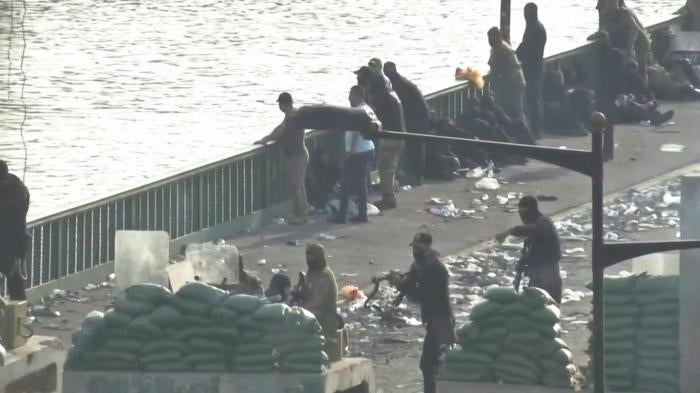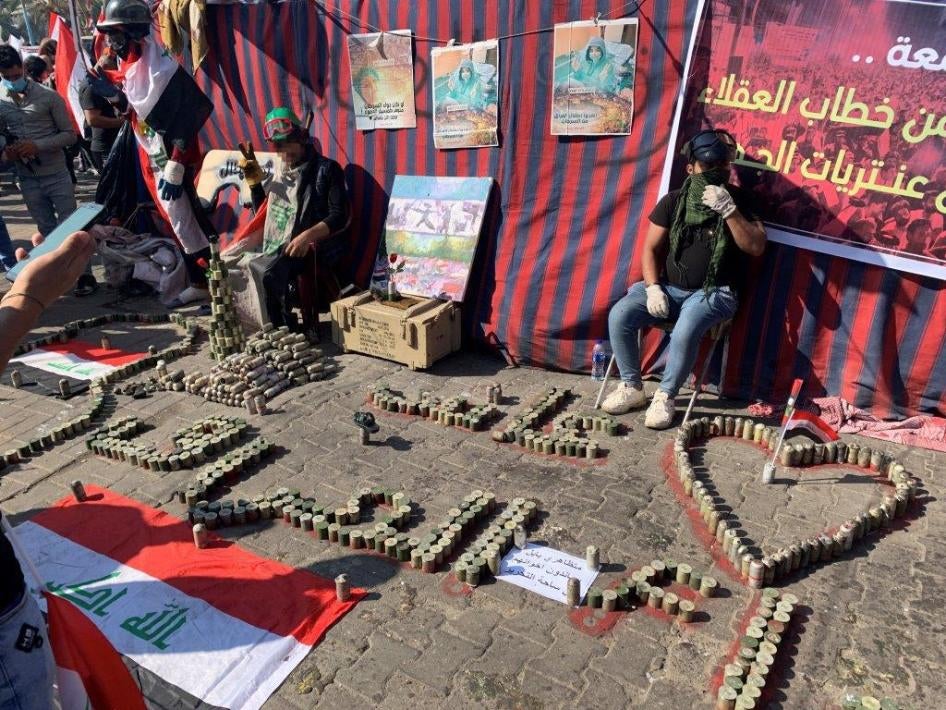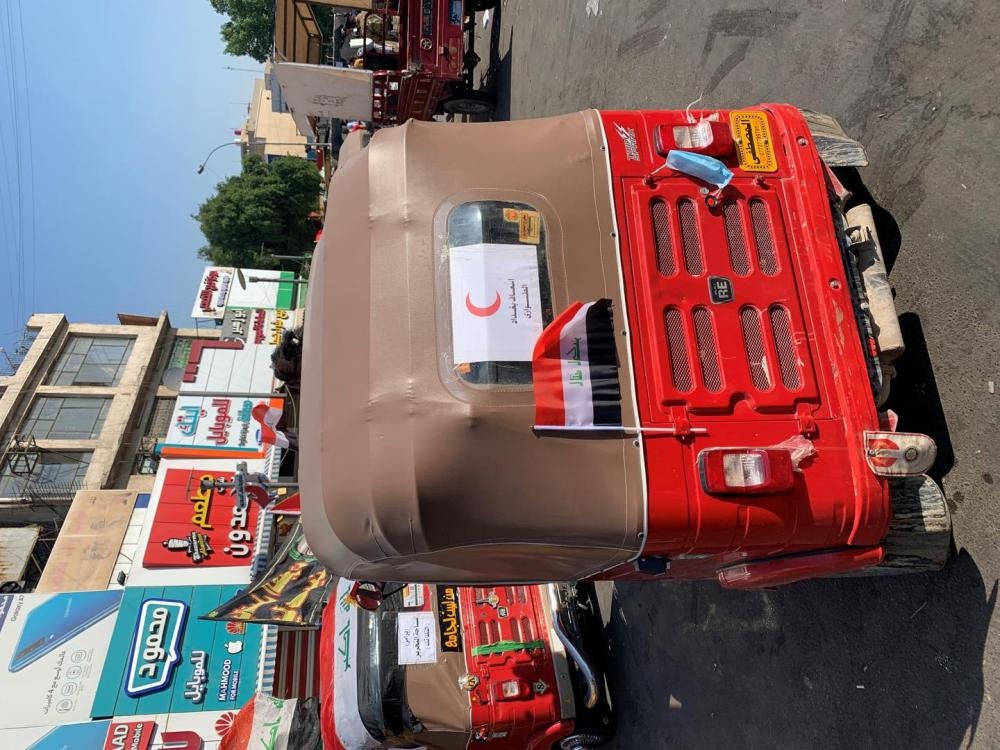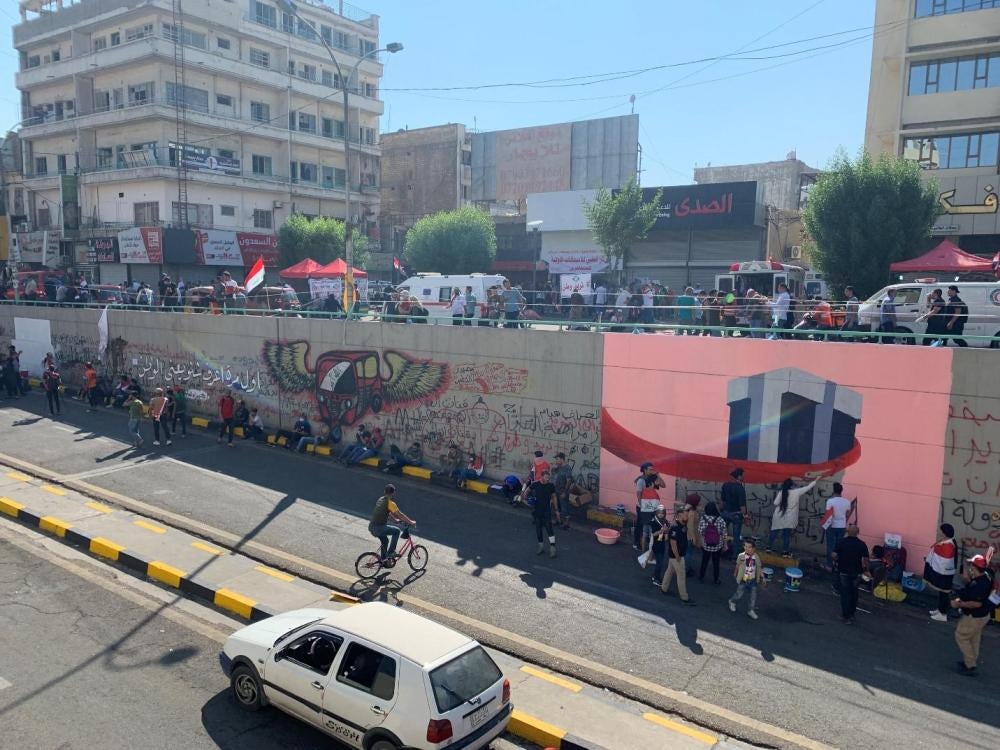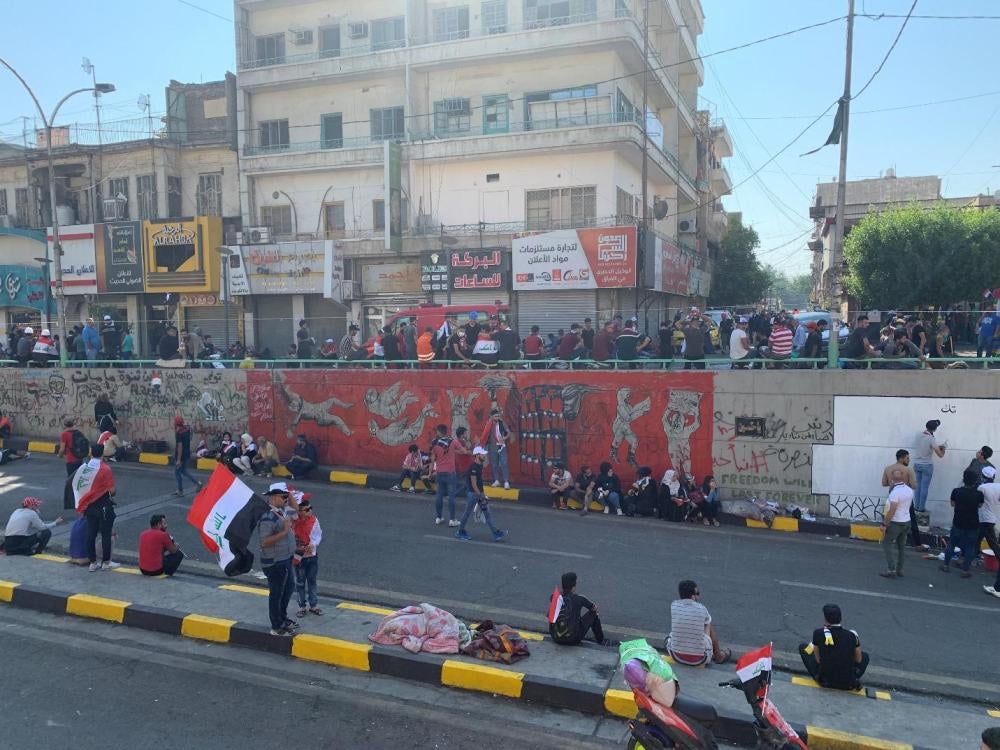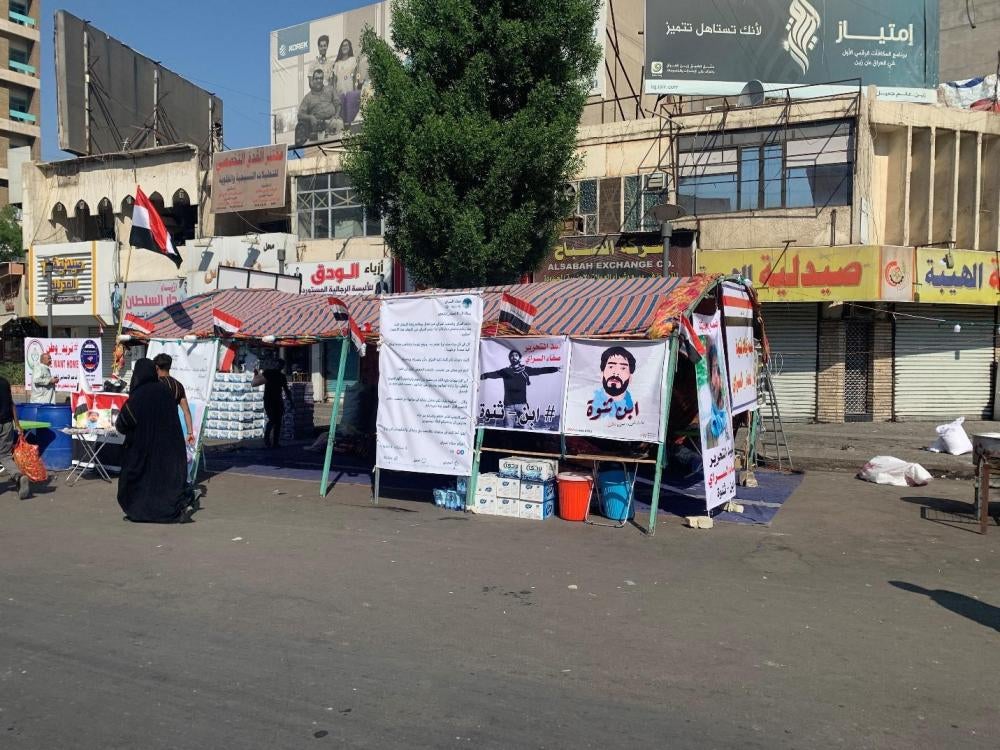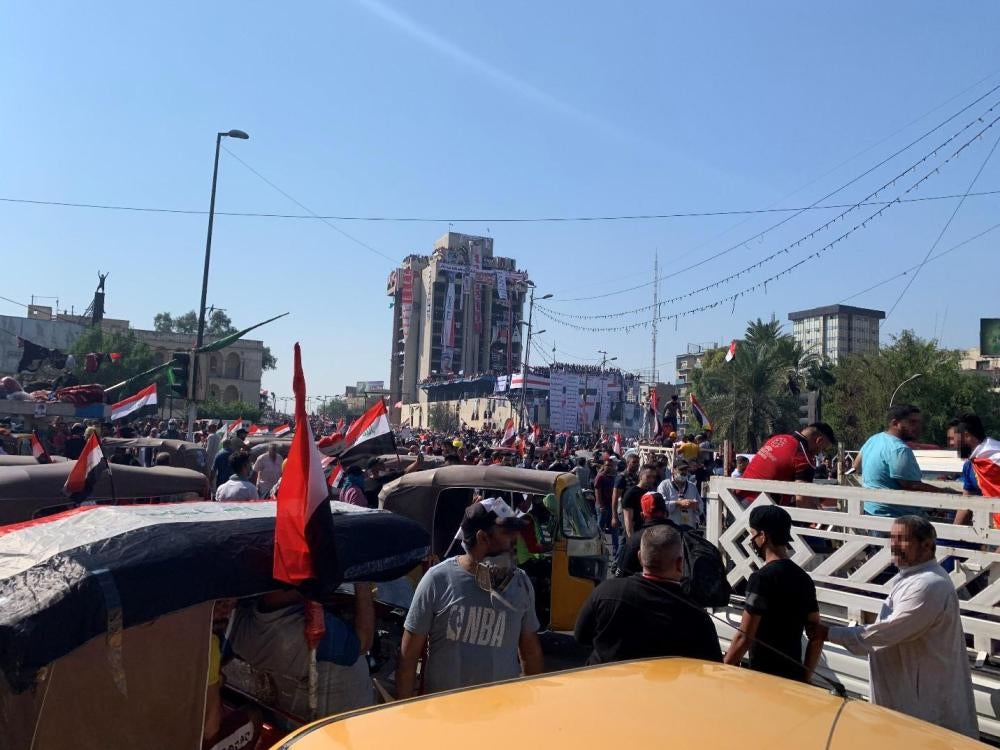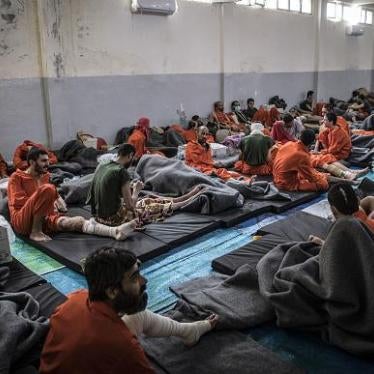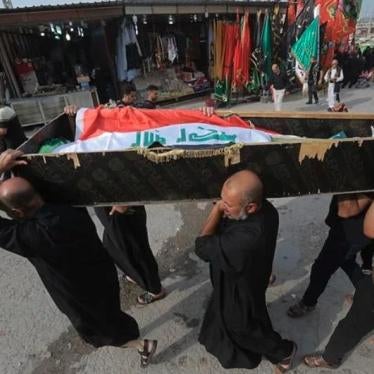(Beirut) – Security forces have fired teargas cartridges directly at protesters in Baghdad, Iraq on numerous occasions since protests resumed on October 25, 2019, killing at least 16, Human Rights Watch said today. The dead are among the large number of protesters Iraqi forces have killed since daily protests began in Baghdad and in other cities in southern Iraq against corruption and for better public services, among other demands.
According to a November 5 United Nations Assistance Mission in Iraq (UNAMI) report, the nationwide death toll from October 25 through November 4 reached at least 97. The Iraqi High Commission for Human Rights (IHCHR) tallied at least 105 dead and 5,655 injured during that same period. From November 5 to 6, Reuters reported that security forces had killed at least six more protesters.
“The high death toll includes people who took direct hits to the head from teargas cartridges, in numbers that suggest a gruesome pattern rather than isolated accidents,” said Sarah Leah Whitson, Middle East director at Human Rights Watch. “With the death toll now at over 100, all of Iraq’s global partners should be unequivocal in their condemnation.”
From October 25 to November 2, security forces’ use of force in Baghdad alone led to the deaths of at least 64 people, sources monitoring the death toll in Baghdad said. Human Rights Watch interviewed 24 people who have participated in protests in Baghdad, Basra, Karbala, Maysan, Nasriya and Basra. The names of many sources cited in this report are being withheld because they spoke on condition of anonymity, citing a fear of reprisal.
Through interviews, researchers’ visits to Tahrir Square, and the review of over a dozen video clips filmed by media outlets, Human Rights Watch has received information about at least 12 deaths in Baghdad caused by teargas cartridges hitting people in the head. The UNAMI report put the death toll from teargas cartridges penetrating upper bodies at at least 16.
Human Rights Watch has also documented internet slowdowns and social media and other media blockages and shutdowns since the protests began.
Human Rights Watch analyzed Reuters footage taken on October 27 and 29, which it corroborated with witness interviews. The footage shows security forces on Jumhuriya Bridge firing into the crowds at the foot of the bridge, which opens onto Tahrir Square. The October 27 clip shows one officer to the right firing teargas cartridges in an upward trajectory while on the left another officer is firing in a flat trajectory at crowds of protesters less than 100 meters away.
An analyst at the Omega Research Foundation, an independent research group focusing on the manufacture, trade, and use of military, security, and police equipment, reviewed this clip for Human Rights Watch and said that:
The man on the left is likely to be aiming directly at the people he is targeting. This carries a high risk of causing serious injury or death if teargas cartridges are being fired. In the second clip [taken on October 29], both people who are using launchers are firing on a flat trajectory. Again, this is an inappropriate and highly dangerous use of teargas cartridges.
The contrast in firing techniques raises the question of whether some forces are operating side-by-side under different orders, whether they all have orders to disperse the crowds in any way they see fit, or whether forces are disregarding their orders, Human Rights Watch said.
While relying increasingly on teargas in Baghdad, security forces are continuing to use live ammunition. Between November 4 and 6, live ammunition killed at least 14 more protesters in Baghdad, according to Reuters. Human Rights Watch reviewed three videos identifiably shot at Jumhuriya Bridge, and shared via social media between October 25 and November 5, showing dead protesters with wounds to the head that do not appear to have been caused by teargas cartridges.
Allegations of excessive force outside of Baghdad also continue, particularly in Karbala, with witnesses, UNAMI, and media reports all saying that security forces killed at least 17 protesters between October 28 and November 3.
Since the protests began, senior government officials have forbidden medical staff from sharing information on the dead and injured with any sources outside the Health Ministry, and the ministry has been releasing minimal and incomplete information. The IHCHR stopped updating its national tally as of October 31.
A doctor in a facility receiving the dead and wounded from the protests interviewed anonymously told AFP he thought the actual death toll since October 25 was much higher than the one being reported by the IHCHR. A person with links to Iraq’s morgues told Human Rights Watch she agreed with this assessment.
UNAMI recorded six abductions of protestors or volunteers providing assistance in the Baghdad demonstrations during the current wave of protests. In one case, the sister of Saba Farhan Hameed, 36, who had been providing food, water, and first aid kits to protesters in Tahrir Square, said Hameed vanished around 11:15 p.m. on November 2 while en route home. A colleague who had been on the phone with Hameed heard her scream and her phone went off. Her sister has since gone to several police stations to search for Hameed but has not been able to locate her.
Under international human rights standards, law enforcement may use force only when strictly necessary and to the extent required to achieve a legitimate policing objective. Forces should only use teargas when necessary to prevent further physical harm; where possible, they should issue warnings before firing. They should take into account the likely impact of their use of teargas, especially in enclosed spaces or if fired at close range, on vulnerable groups, including children. During violent protests, the use of teargas should be proportional to the seriousness of the offense, should meet a legitimate law enforcement objective, and should preferably be used alongside other non-lethal methods. The deliberate use of lethal force is permissible only when it is strictly necessary to protect life.
The UN Basic Principles on the Use of Force and Firearms by Law Enforcement Officials require authorities to promptly report on and investigate all incidents of law enforcement officials killing or injuring people with firearms through an independent administrative or prosecutorial process.
Iraqi authorities should respect the rights to freedom of expression and assembly, allowing all Iraqis to demonstrate peacefully and all journalists to film and report on the protests. Given the scale of law enforcement officials’ apparent use of excessive and lethal force over an extended period of time, the Iraqi government should launch an investigation into each and every death by the security forces, with the help of international experts if necessary, Human Rights Watch said. Such investigations should be speedy, fair, and independent of those being investigated with the participation of the families of those killed, and should lead to prosecutions of anyone found to have broken the law, including commanders.
Countries that have provided military and law enforcement training and support to Iraq – including the United States, European Union states, and Iran should end assistance to units involved in serious violations unless the authorities hold abusers accountable and curtail the abuses. The countries should explain publicly the grounds for suspending or ending military assistance. While the UN, US, and EU have issued multiple statements condemning the excessive use of force, Iran, another key partner to Iraq, has withheld censure.
“Given Iraq’s history of civil unrest and international training not only for military operations but also for crowd control, Iraqi authorities should not get a free pass for misusing teargas as a lethal weapon instead of a crowd dispersal method,” Whitson said.
Interference with Media, Internet Blocking
Since October 25, Iraqis in central and southern Iraq have reported having no access to social media platforms except when using a virtual private network. They also report slower-than-usual internet speeds. From October 27 to November 2, Human Rights Watch researchers in Baghdad were able to access internet at slow speeds, but unable to access most communication applications without use of a VPN and even then experienced severe connectivity difficulties.
In an email on October 30, a representative of NetBlocks, an independent, international, non-partisan group monitoring internet access and a range of other digital rights, told Human Rights Watch that the organization had observed near-total shutdowns and a nightly internet curfew between October 2 and 11, followed by weeks of service restrictions during the ongoing protests: “It’s been 30 days since the social media platforms including Twitter, Facebook and Instagram are blocked and messaging platforms including WhatsApp and Telegram are degraded for most users. The disruptions in Iraq now rank amongst the most severe NetBlocks has observed in any country in 2019.” Netblocks reported that on November 4 at midnight local time, the internet was again completely shut down in most of the country. The shutdowns continued on November 5 after a respite of several hours.
During the first wave of protests in early October, four journalists and the Iraqi Journalists’ Syndicate said the crackdown on outlets airing protest footage was acute, with raids on outlet offices and channels being pulled off the air. Since the protests resumed on October 25, the government has eased the pressure not to broadcast such footage. However, a local journalist in Karbala, which has had daily protests, said that on October 28 at about noon, he saw security forces arrest a local outlet’s cameraman as he filmed the protest. The local journalist said that half an hour later, soldiers surrounded him while he was filming, arrested him, and accused him of “inciting people to protest” through his media work. They released him after 30 minutes but told him that they would keep arresting journalists.
The UNAMI report cited raids on and suspensions of six local media outlets between October 25 and 26.
Teargas
The November 5 UNAMI report put the death toll from teargas cartridges to the head and chest at 16 at least. The IHCHR reported that on October 25 alone, eight people were killed in this way. Amnesty International reported that it had spoken to two protesters who had witnessed deaths on October 26 and 28 from teargas cartridges hitting people in the head.
Human Rights Watch interviewed a protester who said she saw another protester get hit in the head and killed by a teargas cartridge on October 29. She said the victim was not trying to approach security forces at the time, but was just in the square, dancing and talking. Another protester said he saw a man killed by a teargas cartridge that hit him in the head on October 28 on Jumhuriya Bridge. Both witnesses said that they did not hear the security forces giving any oral warning before opening fire.
An activist shared a video clip that apparently showed officers opening fire with teargas cartridges on November 1 on protesters along the river, hitting a man in the head and killing him.
On November 1, the IHCHR reported, security forces killed a woman with a teargas cartridge to her head on Jumhuriya Bridge.
Human Rights Watch has been unable to ascertain the rank and affiliation of the officers stationed on Jumhuriya Bridge since October 25 who were firing teargas.
An international military expert in Baghdad said that in his view, when the Iraqi security forces fired teargas cartridges directly at a crowd, it was “not an issue of training, but a level of intention, showing that security forces are absolutely using these projectiles as a weapon as opposed to a dispersal mechanism.” The standard practices and procedures used by security forces for riot control, as well as the instructions provided by manufacturers, dictate that tear gas cartridges should not be fired directly at people. An international observer with crowd control experience in Baghdad also said that in her view the security forces were sometimes using teargas cartridges for the same purpose as they used live bullets.
Adequate Training
Human Rights Watch raised questions about the level of crowd control training Iraqi forces had received with diplomats from four embassies in a meeting on October 29. They said that their governments had focused on training for military and counterterrorism operations more than on crowd control. However, over the past years, Italy, France, and the US have provided Iraqi Forces some crowd-control training. Iraqi forces have also dealt with protests and civil unrest for years, including during large-scale protests in 2010, 2011, 2013, 2016, and 2018.
Alleged Expired Cartridges
Protesters have alleged since the protests began that security forces are using expired teargas cartridges. Researchers visited the Baghdad protest on November 1 and saw dozens of teargas cartridges that had been collected by protesters after they had been fired. Many had dates listed on them from 2009 to 2014, but these are most likely production dates, not expiration dates. Human Rights Watch was unable to ascertain if the cartridges had expired.
The Omega Research Foundation shared analysis with Human Rights Watch that concluded that expired teargas is dangerous for many reasons. Without taking a position on whether expired cartridges were in use in Iraq, they concluded: “Expired equipment should not be in use on the street. It should be taken out of circulation and destroyed according to careful environmental protocols for waste disposal.”
Changing Teargas Symptoms
On November 1, two doctors separately told Human Rights Watch that on the evening of October 31, they received at least 10 protesters in their tent who showed a set of symptoms different from those experienced by earlier victims of teargas exposure. They said the more recent victims went into spasms, shock, breathing difficulty, and paralysis for about 10 minutes before the symptoms started to pass. They showed Human Rights Watch a video capturing the symptoms. The IHCHR expressed concern about the apparent change in symptoms, though it remains unclear what may be causing them.
Karbala
Reports emerged that on the night of October 28, armed forces opened fire on protesters in Karbala, killing between 14 and 18, according to several international media outlets that said they were able to verify the casualties with unnamed security sources, even though public officials denied the incident. A local journalist there told Human Rights Watch that he saw security forces open fire on crowds of protesters that night and saw one protester he recognized dead from a gunshot wound in the morgue the next morning.
Human Rights Watch interviewed a doctor who was on his shift that night at the morgue and who said that he saw the bodies of seven protesters who had been shot and killed. Another medical worker shared videos she said she filmed that night, showing four bodies. UNAMI received what it viewed as credible allegations that security forces killed 18 protesters.
The Karbala doctor said he personally knows the family of one of the victims. He said the family tried to retrieve their son’s body, “But the hospital refused to give it to them unless they signed a document that they would not bring a legal suit against the government or a tribal claim. The family refused to sign and so they still don’t have the body back.”
A man in Karbala said that on the night of November 3, he and about 200 other protesters were heading to the Iranian consulate to demonstrate outside. He said Iraqi Security Forces there did not stop the protesters from putting an Iraqi flag on top of the consulate, but that at about 10:30 p.m., a group of teenagers threw several Molotov cocktails at the consulate building. Armed men arrived in SWAT-marked vehicles and started firing on the protesters. “I saw one man who was filming the protest get shot in the chest,” he said. Reuters reported that three protesters were shot and killed at the confrontation near the Iranian consulate.
